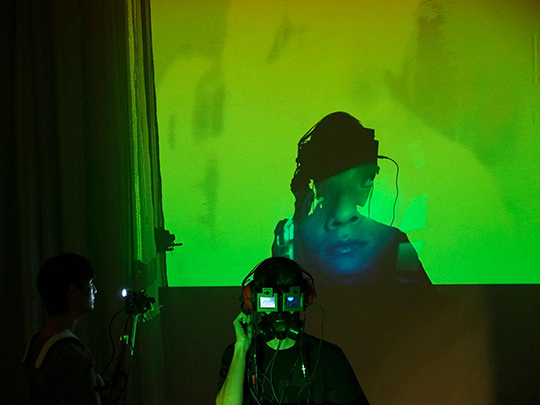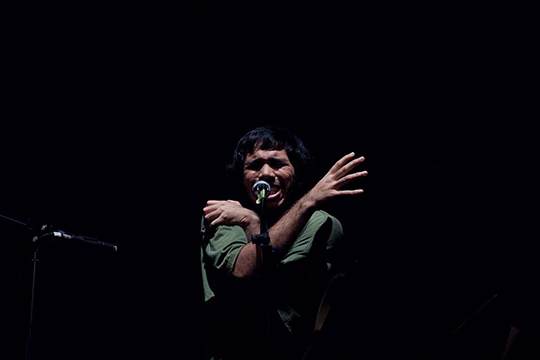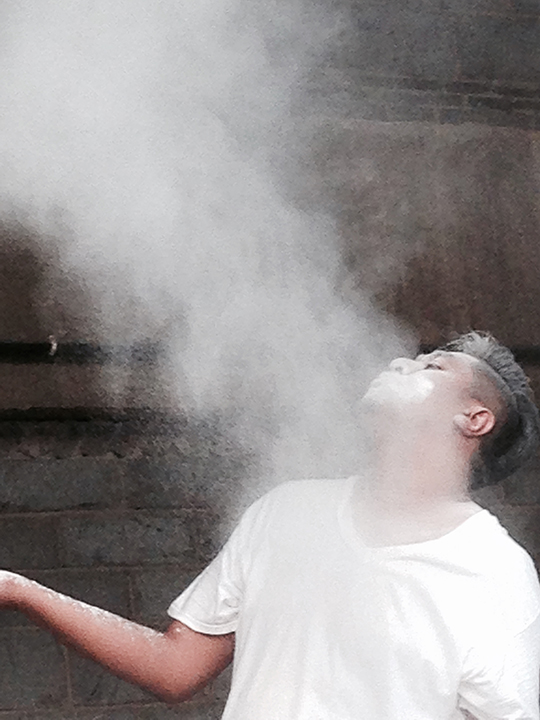PERFORMANCE ▶
INTER|ACTIONS: TRANSGRESSING BOUNDARIES
MICKAËL ROBERT-GONÇALVES You are what I don't want to be – A performance by Ezzam Rahman & Pascal Battus, Eglise Saint-Merry; Paris, 7 June 2015
Singapour mon amour's performance module INTER|actions comprises four commissioned performances ranging from a live ciné-concert, to audiovisual, body and sound performances. Each creation questions the notion of "frontiers" by highlighting the strength of interdisciplinary and intercultural collaborations which focus on the capacity of the moving body – the human, filmic and musical – to produce innovative and thought provoking forms.
You are what I don't want to be – A performance by Ezzam Rahman & Pascal Battus, Eglise Saint-Merry; Paris, 7 June 2015
Singapour mon amour's performance module INTER|actions comprises four commissioned performances ranging from a live ciné-concert, to audiovisual, body and sound performances. Each creation questions the notion of "frontiers" by highlighting the strength of interdisciplinary and intercultural collaborations which focus on the capacity of the moving body – the human, filmic and musical – to produce innovative and thought provoking forms.

Urich Lau and Teow Yue Han, Life Circuit, 2012 © Nah Yong En
Urich Lau, Teow Yue Han, Life Circuit, 2009-2015, 60'
Conceived by Urich Lau in 2009, Life Circuit is an ongoing performance project that explores the intersections of performance, video, music, new media and sound art. The improvisational and collaborative potential of the project lies in the audience's participation which makes each presentation of Life Circuit unique and unpredictable and which challenges the conventional relationship between the artist and the audience. The two catalyst actors are Urich Lau, positioned in front of a big screen, looking like a robotic DJ with a reconstructed gas mask, welding goggles and earmuffs, and Teow Yue Han, wearing a special equipment made out of small screens and a camera which provides live-feed images and sounds that are linked to other devices and displays. These electronic extensions to the artists' bodies replace their visual, audible and vocal senses of perception and expression. In the setting of Saint-Merry Church, this “circuit” resonated in a creative assemblage of images, whisperings, sounds and textual extracts from National Arts Council's mission statement. The frictions between the predetermined framework and electronically filtered elements found within the audience and the exhibition space created a sensuous experience of interactivity between the artists, the audience's physicality and the electronic gadgets.

Bani Haykal during B-Quartet's last gig © Hoong Wei Long
Bani Haykal, The Public Assembly, 2015, 60'
Bani Haykal's The Public Assembly is a durational performance consisting of several players: the artist, two chess players and an ensemble of choristers. The artist sets the note by reading historical and contemporary texts dealing with “the politics of cultural diplomacy”. Equipped with a megaphone these readings vary in tone and volume and include instructions for the two chess players to kick off their game. Depending on their moves and instructions received by the artist, it is their turn to command performative reading instructions to the choir members, divided into two groups. Each member of the choir disposes of a text that deals likewise with cultural politics. During the performance shifts of power can be observed within the three parties, based on the volume and intensity of verbal expression, as well as the bodily involvement. The artist's desire to provoke a disturbing result becomes obvious: the performance is without doubt enjoyable and entertaining for its participants, yet for the audience arises the question if they are part of this happening or if they are solely puppets on a playground. By considering the audience in this way, The Public Assembly transgresses a border and questions the daily game of politics and our submission, or not, to these orders.

Ezzam Rahman, Yan/Smoke, 2014 © Daniela Beltrani
Ezzam Rahman vs Pascal Battus, You are what I don't want to be, 2015, 60'
The performance You are what I don't want to be is rooted in Ezzam Rahman's experience of letting go of some of his closest friends who left Singapore for other countries. This massive wave of departures made him wonder if the grass is actually greener on the other side. Through an intense body performance using white talcum powder and feathers as symbolic elements, Ezzam Rahman reflects on transformation, the becoming of someone else by external elements and influences, and the notions of migration and impermanence. His circular and hypnotic choreography reacts to an experimental live soundtrack performed by French musician Pascal Battus whose enigmatic metallic sounds elevate the performer’s actions to a timeless and universal journey of the human being. The distinctive paradox between the ephemeral character of feathers and powder and their concomitant strong material presence, highlights the questioning of the sense of belonging and the tensions of leaving versus staying, searching versus finding.

Ho Tzu Nyen, EARTH, 2009
Ho Tzu Nyen vs FOUDRE!, Christine Ott, Paul Régimbeau, EARTH [FOUDRE!], 2009-2015, 42'
In Ho Tzu Nyen’s masterpiece’s EARTH, we see the site of an unknown disaster, the debris of history that constitutes the story of our Earth. Fifty humans are lying there drifting between consciousness and unconsciousness, life and death. Occasionally, one of them emerges into the foreground – clenching a fist, batting an eyelid, or shedding tears for his neighbour. At other times, these figures recede from the light, losing their individual shapes to form a gigantic organism, breathing in unison, pulsating like a jellyfish on their journey across Earth.
EARTH has been shown worldwide with various soundtracks by Black To Comm and Oren Ambarchi amongst others, and the performance at Saint-Marry created the opportunity for a collaboration with FOUDRE! composed by Frédéric D. Oberland (Oiseaux-Tempête, FareWell Poetry), Romain Barbot and Grégory Buffier (Saåad). For this special expanded cinema performance, the trio invited ondes Martenot's virtuoso Christine Ott (Tindersticks, Yann Tiersen) and the electronic/noise artist Paul Régimbeau. In this unique constellation a captivating live soundtrack of progressive electronic pulsations was created that magnified the experience of watching a film by creating a total work of art which included the film, the sound and also the gothic architecture of the church.






